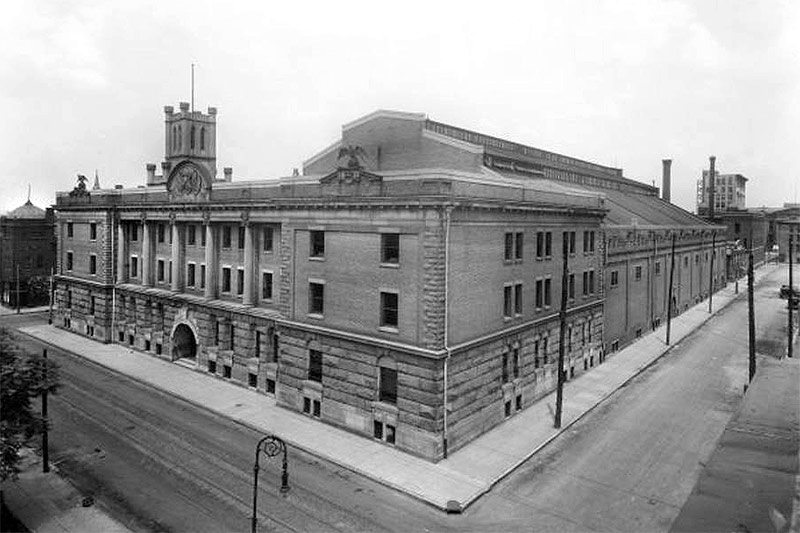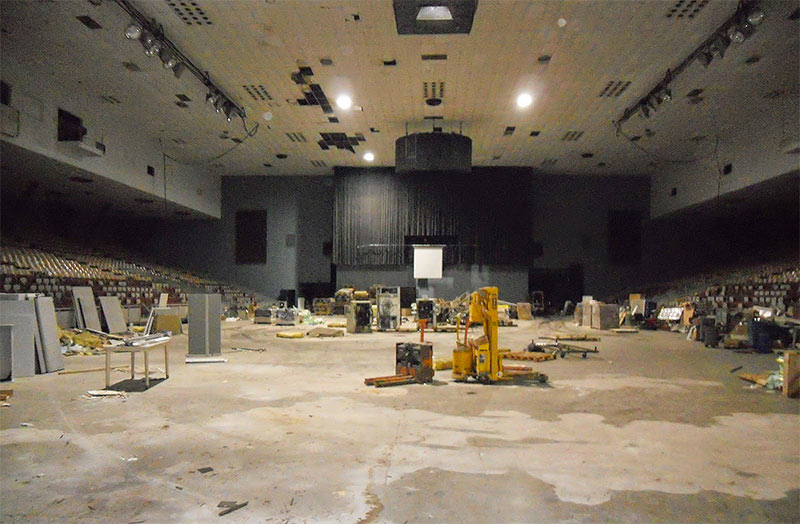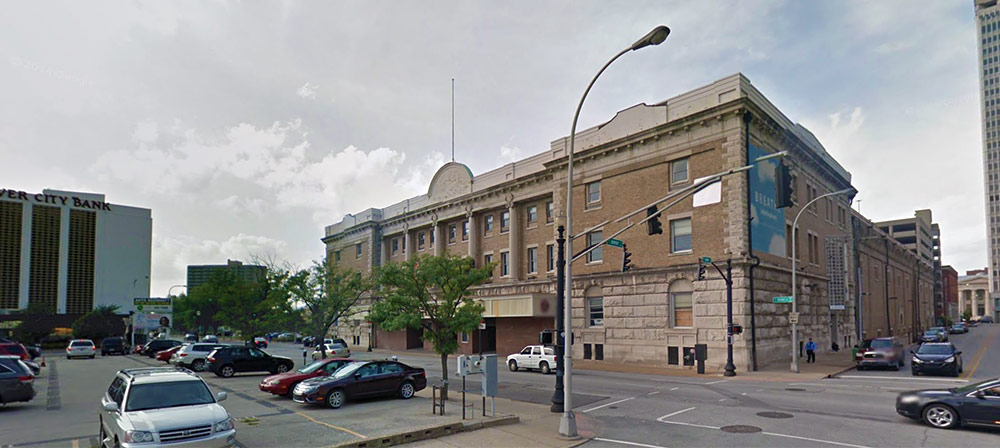Louisville’s Armory—more recently called the Louisville Gardens—has been languishing for years on the corner of Sixth Street and Muhammad Ali Boulevard in Downtown Louisville. Currently used as a warehouse for Metro Louisville, the gargantuan facility built in 1905 has one of the most storied histories in Louisville (check out a portion of that history here), yet it’s sheer size has presented challenges for redeveloping the space.
In 2007, 4th Street Live! developer, Baltimore-based Cordish Companies, had proposed converting the facility into a venue for minor league hockey as part of its $250 million Center City project to remake not just the armory, but also the so-called Water Company Block several blocks east at Third Street. Cordish has since backed out of its armory promises and the city has been left holding a hot potato that reportedly costs over $20,000 a year on maintenance and utilities.
“Louisville Gardens and Cordish is optional now. So the city can move how we want and they can too. So it gives us more flexibility in terms of what the next steps are with Louisville Gardens,” Fischer told WDRB in 2012.

Once a thriving venue for special events, the armory space is in need of a major renovation to make it competitive as a venue, so the city is exploring other options. A Request for Proposals (RFP) for the building was issued by the city in collaboration with city-property-marketing site OpportunitySpace seeking ideas from developers for reusing the building. The deadline to submit ended on August 29. So do we have a redevelopment plan for the armory? Not yet.

After months of speculation, Louisville’s Underhill Associates (UA), developers of Westport Village and the Germantown Mill Lofts, appears to be the only firm to have responded to the city’s RFP, the Courier-Journal reported last week. The firm’s proposal calls for an investment of $20 million to create a mix of uses, including “extensive” retail and 60 or more apartments. Jeff Underhill, partner at UA, told the newspaper that negotiations with the city are ongoing and no deal is in place yet to redevelop the property:
But he [Underhill] also said the city appears to be in no hurry to strike a deal involving the century-old site, which originally was an armory and later became a longtime venue for major events. The city, Underhill said, seems “to have nothing real pressing on it right now” and “hasn’t expressed that it wants to move forward” on a Gardens deal. “I don’t think they have made a clear-cut decision on what they want.”
Underhill said the city may have some long-range, community use in mind—such as a casino, if expanded gambling legislation is ever approved in the state legislature.
Mayor Fischer’s spokesman, Chris Poynter, told the C-J that there’s no timeline in place for announcing a winner of the RFP.

The C-J elaborated on the Underhill’s plans:
Underhill said his firm is not asking for financial incentives from the city and offered an undisclosed amount for the property. He said any renovation might hinge on being able to get approval to use state historic preservation tax credits that would likely reduce the needed equity.
Underhill said his company proposed extensive renovation of the three-story Gardens, which could be redeveloped with about 200,000 square feet of space. Much of the interior would have to be reconstructed; it has an arena layout with seating for about 6,000 on three sides and an open area on the north end for a performance stage.
Until the city makes up its mind that it wants to proceed or not with that plan, the project is in limbo. While we wait, let’s brainstorm what kinds of uses would make a good fit at the armory.

The armory building contains some 220,000 square feet overall, including a three-story administrative section up front, a basement, and a massive 55,000-square-foot space—about 200 feet by 270 feet—with bleachers in back. (And if you look closely along the building sides, scuppers appear to be shaped as cannons pointing out from the top of the structure.)
That amount (and configuration) of space is a challenge for adapting to modern uses, but it’s not impossible. Many cities across the country are looking at urban markets or grocery stores for such spaces. Here are a couple of the nation’s leading examples:
- In Philadelphia, the Reading Terminal Market is a labyrinth of vendor stalls arranged in 75,000 square feet inside an historic train station shed. Read more about the market at the Project for Public Spaces.
- San Francisco’s Ferry Building Marketplace is another great example.
- At a recent ULI conference in New York, I attended a presentation on food as placemaking featuring Steve Boyle, the developer of Washington, D.C.’s 25,000 square foot Union Market. That project helped revive a forgotten stretch of the nation’s capital using food and other tactical urbanism events.
- At the same conference, Margaret Cafarelli presented her Santa Barbara Public Market project.
- Jamestown Properties has developed food- and market-driven developments like the 100,000 square foot Chelsea Market in New York built inside of a former Nabisco factory that once made Oreos.
- In Atlanta, Jamestown is working on finishing up the Ponce City Market project that includes 300,000 square feet of market space. I spoke with the company’s president, Michael Phillips, earlier this year for The Architect’s Newspaper to get his opinion on market-based development.
- Lastly, for an over-the-top example of market architecture, this market in Rotterdam opened this year with apartments actually forming an enormous arch over top of the public market hall below. This just shows anything is really possible.
The big takeaway from the ULI conference and from my conversations with Jamestown is that a successful food hall must not fall short and become a simple food court. “We’ve learned that a great food hall has to remain committed to raw food for people cooking meals, not just cooked food that you buy and can take away,” Phillips said. “You have to be able to make a meal out of it, which is something we really adhered to at Chelsea Market. A butcher, a fishmonger, a cheesemonger, a vegetable seller, those are all really important aspects of a food hall.”
Could such a market work at Louisville’s armory building? Operating such a facility is certainly a challenge, but it could make a big impact on Downtown and its ability to attract new residents.
If a true public market proves infeasible, another option could be to include a grocery store in the armory’s main hall, with a mix of apartments and retail in the remaining space. Chain stores like Whole Foods and Trader Joe’s have been known to embrace urban stores and even to seek out quirky-yet-grand spaces like the armory. An even bigger win would be if a local company operated a grocery in the space. Grand spaces like the armory’s enormous steel-arched span create inspiring places for public amenities that are open to everyone all the time, a big advantage over using the space as a venue. Check out Cleveland’s West Side Market or this Trader Joe’s in Brooklyn for examples of grocery shopping on a higher architectural level.
In the front portion of the building, apartments make a lot of sense, but perhaps we could boost the number of units in the space by building a small addition onto the top of the structure. For the sake of discussion, below is a quick-five-minute-rendering of what something like that could look like.
Whether or not the city chooses to proceed with the Underhill’s plans at the armory, we should begin to have in mind how we want the space to function as an asset to urban life. I think a market or grocery store surrounded by a mix of apartments and retail makes a lot of sense. What would you like to see happen at the armory site?




Man, I would love to know what happened to those decorative pieces that once adorned the front facade (especially those two eagles).
I’m I the only one who cannot stand this building. What am I missing here. It’s an enormous, brick barn. Nothing more. It sits in one of downtown’s many wastelands with no curb appeal. The fact that the city won’t demolish the Gardens but instead throws $20k a year on utilities for storage space shows you how unprogressive Louisville remains.
What a great asset for the community, but I would love to see a new and different idea to renew interest in the building. No doubt, the Underhill’s would turn this into a vibrant and locally sourced mix of residential and light commercial space. While full of potential, I find that idea somewhat lacking in originality.
I still think we should not abandon the idea of renovating the arena for multi-use sports and events. some people may say this is a saturated market, but I certainly believe there is a need for a 5,000-7,000 arena here in Louisville. first,the we are losing High School state basketball to Rupp Arena, which is a tragedy. Second, we actually attract some awesome AAU tournaments to the expo center every summer. wouldn’t playing in a newly renovated “Garden” be more appealing to kids then an over-spacious and under-supported Freedom Hall?
Lets think about this further. Louisville has shown we can be successful with minor league sports. The Bats and now newly formed USL team, Louisville City FC, are driving interest in pro teams w/out zapping the bank account. An NBA D-League(Half the team would be from Kentucky)team and Minor league hockey team(River Frogs) would thrive in a location like this. The $1 beer nights would bring the university crowd out on weeknights. Young people would be enjoying the sights and sounds outside of just the Yum Center and 4th Street Live. 4th street live struggles to stay in business outside of conventions, and bringing an extra 5,000-10,000 people a week to downtown would do wonders for the floundering businesses. Also, think of major acts like Dave Chappelle coming to town this week. Do you think he would be better to do one big show at the Garden instead of 3 shows spread over two nights at the Palace? The Garden is a prefect size for several music and comedic acts. We just don’t know because we don’t have the venue to support it. Additionally, its not like this building wouldn’t compliment what already happens at great venues right next to it (Mercury Ballroom, The Palace, The Brown, etc..,.) this could be Louisville’s answer to Broadway.
We talk all the time on how we need to get downtown more livable and that begins in making it more sustainable. The restaurants & shops need to count on people COMING to downtown to frequent their businesses. We don’t have enough people LIVING downtown to make it an organic experience like the Highlands.
We can make all the residential units and friendly market space in the world, but we need to set up cornerstones that attract people to the area on a continual basis. I’m not saying increased residential space is a bad thing, I am actually all for it. But the Garden is too unique of a space to just settle for turning it into a mixed use development. We need to see this as an opportunity to do something special.
side note: if i was a bourbon distillery looking to relocate to downtown Louisville, I would seriously consider the viability of The Louisville Gardens…
sorry for rambling
I spoke with the Manager of The Hofbrauhaus in Newport, Ky and told him about Louisville Gardens. He said he would LOVE to bring one of these restaurants to Louisville.
If you are not familiar with The Hofbrauhaus, it is a German Restaurant and they brew their own FAMOUS German Beer. The Same Beer recipe for over 400 years.
The Hofbrauhaus would be a PERFECT Addition to the “Beer Trail” that Louisville is trying to do (following the Bourbon Trail example). The Hofbrauhaus is one of the most famous restaurants in the world.
They just built one in Columbus, Ohio.
I emailed the City about this and no one ever replied.. Not sure if anyone followed up on this.
http://www.hofbrauhausnewport.com
Where would the garden be located?